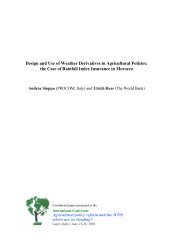Use of decision support systems to improve dam planning and dam ...
Use of decision support systems to improve dam planning and dam ...
Use of decision support systems to improve dam planning and dam ...
Create successful ePaper yourself
Turn your PDF publications into a flip-book with our unique Google optimized e-Paper software.
<strong>to</strong> pay sufficient attention <strong>to</strong> environmental impacts <strong>and</strong> those, invariably poor people adversely affected by<br />
their construction <strong>and</strong> operation. Those who have had <strong>to</strong> be resettled <strong>and</strong> those whose livelihoods have been<br />
affected by changes in river flow regimes have tended <strong>to</strong> pay the price <strong>of</strong> <strong>dam</strong> construction (Box 1.1).<br />
In Africa, relatively few large <strong>dam</strong>s have been built <strong>and</strong>, after Asia, the continent has the lowest per capita<br />
s<strong>to</strong>rage <strong>of</strong> any continent (Figure 1.1). Although the need for economic development is urgent, many people<br />
continue <strong>to</strong> rely on natural resources <strong>and</strong> agriculture <strong>to</strong> sustain their livelihoods. Consequently, assessing all<br />
the implications <strong>of</strong> <strong>dam</strong>s, both positive <strong>and</strong> negative, is <strong>of</strong> paramount importance both when <strong>planning</strong> new<br />
<strong>dam</strong>s <strong>and</strong> when revising the design or operating rules <strong>of</strong> existing ones.<br />
Currently the World Bank, the African Development Bank, the New Partnership for African Development<br />
(NEPAD) <strong>and</strong> other influential institutions are advocating increased development <strong>of</strong> hydraulic infrastructure<br />
on the African continent. The current position <strong>of</strong> the World Bank is that major water resource projects<br />
provide the basis for broad regional development, with “significant direct <strong>and</strong> indirect benefits for poor<br />
people” (World Bank 2004). As a result, many <strong>dam</strong>s are being planned <strong>and</strong> it is likely that many will be built<br />
in the near future. There is no comprehensive list but Appendix 2 provides details <strong>of</strong> some <strong>of</strong> the new <strong>dam</strong>s<br />
currently being built or planned in Africa.<br />
2<br />
Box 1.1. How <strong>dam</strong>s can have adverse impacts on people<br />
Although <strong>dam</strong>s have brought benefits <strong>to</strong> many millions <strong>of</strong> people, their construction has not been without<br />
cost for many others. Globally, it is estimated that between 40 <strong>and</strong> 80 million people have been displaced<br />
as a consequence <strong>of</strong> the construction <strong>of</strong> large <strong>dam</strong>s (WCD 2000a). Many <strong>of</strong> these people have not been<br />
adequately compensated. People living downstream may also be adversely affected as a consequence<br />
<strong>of</strong> changes in flow regimes caused by the way large <strong>dam</strong>s are operated. In many developing countries,<br />
changes in flow, brought about by large <strong>dam</strong>s, have resulted in the degradation <strong>of</strong> natural resources upon<br />
which many people rely.<br />
For example, in some places <strong>dam</strong>s, by reducing flooding, have significantly diminished the productivity<br />
<strong>of</strong> floodplain <strong>and</strong> estuarine fisheries as well as adversely impacting recession agriculture (Acreman et al.<br />
2000). Dams may also cause negative public health impacts, for example, through the creation <strong>of</strong> breeding<br />
habitats for disease vec<strong>to</strong>rs, such as snails for schis<strong>to</strong>somiasis <strong>and</strong> Anopheles mosqui<strong>to</strong>es for malaria (Jobin<br />
1999). People living upstream <strong>of</strong> <strong>dam</strong>s may be 100% affected through loss <strong>of</strong> l<strong>and</strong> <strong>to</strong> the reservoir. More<br />
people downstream may be slightly <strong>to</strong> severely affected by degradation <strong>of</strong> the river system.<br />
An example <strong>of</strong> where a <strong>dam</strong> may have affected the livelihoods <strong>of</strong> people living downstream,<br />
Kafue Flats, Zambia. (Picture source, www.asla.org)





